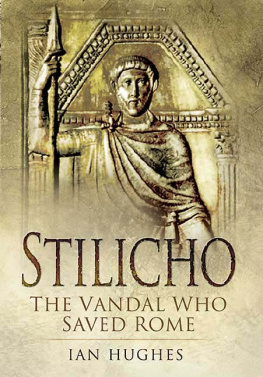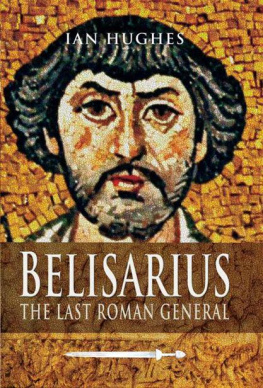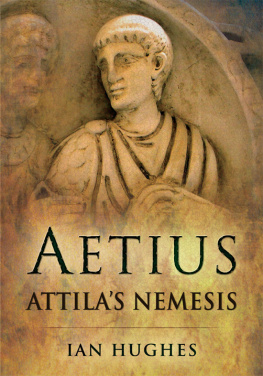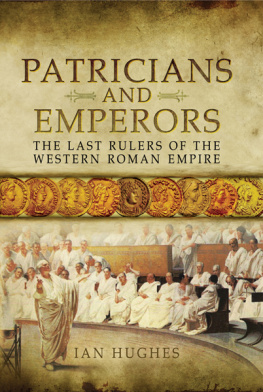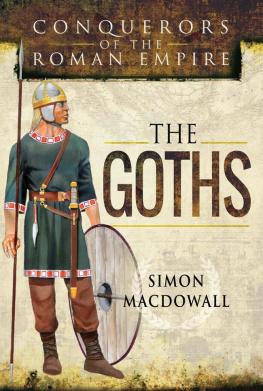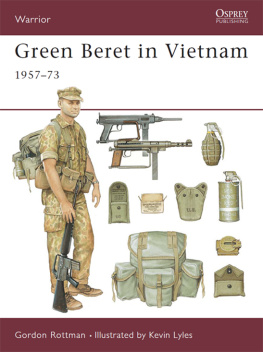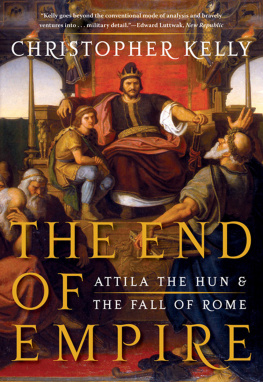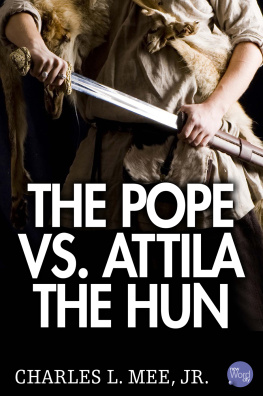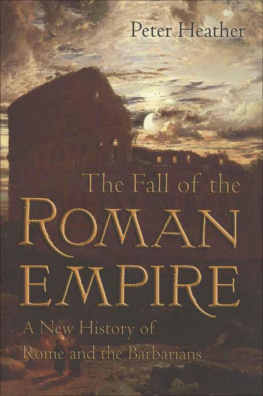Attila the Hun
Attila the Hun
Arch-enemy of Rome
Ian Hughes
First published in Great Britain in 2019 by
Pen & Sword Military
An imprint of
Pen & Sword Books Ltd
Yorkshire Philadelphia
Copyright Ian Hughes 2019
ISBN 978 1 78159 009 6
eISBN 9781473890329
Mobi ISBN 9781473890312
The right of Ian Hughes to be identified as Author of this work has been asserted by him in accordance with the Copyright, Designs and Patents Act 1988.
A CIP catalogue record for this book is available from the British Library.
All rights reserved. No part of this book may be reproduced or transmitted in any form or by any means, electronic or mechanical including photocopying, recording or by any information storage and retrieval system, without permission from the Publisher in writing.
Pen & Sword Books Limited incorporates the imprints of Atlas, Archaeology, Aviation, Discovery, Family History, Fiction, History, Maritime, Military, Military Classics, Politics, Select, Transport, True Crime, Air World, Frontline Publishing, Leo Cooper, Remember When, Seaforth Publishing, The Praetorian Press, Wharncliffe Local History, Wharncliffe Transport, Wharncliffe True Crime and White Owl.
For a complete list of Pen & Sword titles please contact
PEN & SWORD BOOKS LIMITED
47 Church Street, Barnsley, South Yorkshire, S70 2AS, England
E-mail:
Website: www.pen-and-sword.co.uk
Or
PEN AND SWORD BOOKS
1950 Lawrence Rd, Havertown, PA 19083, USA
E-mail:
Website: www.penandswordbooks.com
Acknowledgements
Y et again I must express my gratitude to Philip Sidnell for keeping faith with me. I wouldnt be surprised if, as this is my seventh book, he is now sick of hearing my voice on the telephone asking inane questions!
I would like to thank Evan Schultheis for reading the book and taking the time to discuss significant and contentious details. As usual, the comments, criticisms and corrections have been a valuable asset in the writing process. However, for any mistakes and disagreements I remain solely responsible.
For helping me to secure otherwise impossible-to-acquire books, I would once again like to thank the staff at Thurnscoe Branch Library, Barnsley, and especially Andrea World of the Inter-Library Loans Department of Barnsley Libraries. Without their help this book would have been far shorter and not as comprehensive.
I would very much like to thank the following people for kindly allowing me to use their photographs in the plates: Beast Coins ( www.beastcoins.com ), CNG coins ( www.cngcoins.com ) and Wildwinds Coins ( www.wildwinds.com/coins ). I would especially like to thank Pankaj Tandon of Indian Coins ( http://www.coinindia.com ) for allowing the use of numerous examples of the coins in his collection, as well as for information concerning the production and relevance of these coins; Helen Gooderham and Paddy Shaw for allowing the use of geographical photographs; and Peter Molnar of www.bowshop.eu for allowing the use of the photographs of the Hun bows. Their generosity is very, very much appreciated.
For their patience and for permission to use photographs from their extensive and valuable libraries I would like to thank Professor Manfred Clauss of ILS and http://www.manfredclauss.de , and Dr Andreas Fabender and Professor Manfred G. Schmidt of CIL.
As with my earlier books, this tome would not have been the same without the contribution of the members of both www.romanarmytalk.com/rat and www.unrv.com.forum . They have yet again been exceptionally patient, especially with regard to questions about the availability of photographs.
It goes without saying that my utmost gratitude goes to the individuals and institutions who have made available the ever-growing corpus of source material available on the internet. As with my previous books, I will refrain from mentioning individuals by name, since a look at the bibliography will show that it would need a separate book to list all of the people involved, so to single individuals out for special praise would be unfair. To all of these people, once again, my heartfelt thanks.
Yet at the top of my list remain the two people who have supported me throughout the lengthy process of writing yet another book: Joanna and Owen. Joanna remains in need of praise for her endurance and patience in reading through the book, but at least this time the book is not about yet another bloke from ancient Rome. For her endless patience and understanding, I remain forever in her debt. As for Owen, he really should be given some sort of award for his stoicism in the face of my fixation with a figure from ancient history who is of no interest to him whatsoever. Well, not yet: maybe in time we will come to share the same obsession Then again, maybe not. Only time will tell!
Introduction
M ention the name Attila (or its linguistic equivalent) to anyone over the age of 20 in the West and the chances are that they will have heard of Attila the Hun. The same cannot be said of his near contemporaries whose actions were pivotal during the last years of the Western Roman Empire. The names of Gaiseric the Vandal, Euric the (Visi-) Goth, and the leaders of the other barbarian nations have long since fallen from common usage; Gundobad, the king of the Burgundians, is now more famous as a mountain in Tolkiens Lord of the Rings .
Indeed, even the names of the so-called Germanic tribes that existed in the fifth century ce have evolved and are rarely used for the peoples of the ancient world: Goth is now used as a term for a specific group of young people who listen to depressing music and dress in black; a Vandal is anyone who destroys the property of others without consideration; and Frank apart from being an increasingly-rare personal name is the title given to an individual who shares their views without regard to the feelings of others.
Yet, strangely, into the twentieth century Hun remained in use as a title for a nomadic group who emerged from nowhere to wreak destruction on settled populations before disappearing over the horizon. It is in this context that the term Hun became applied to the German army during the First World War. However, contrary to popular opinion, it was not applied to the German army by the Allies due to the Germans behaviour during this war, but rather thanks to the words of Kaiser Wilhelm II. During a speech given in Bremerhaven on 27 July 1900, when German forces were leaving to suppress the Boxer rebellion in China, Wilhelm stated:
Should you encounter the enemy, he will be defeated! No quarter will be given! Prisoners will not be taken! Whoever falls into your hands is forfeited. Just as a thousand years ago the Huns under their King Attila made a name for themselves, one that even today makes them seem mighty in history and legend, may the name German be affirmed by you in such a way in China that no Chinese will ever again dare to look cross-eyed at a German.
The imperialist and racist connotations of the speech resulted in the German Foreign Office omitting this paragraph from the official transcription, as diplomatically it was embarrassing and would otherwise cause political difficulties which needed to be smoothed over, especially given the nature of the rebellion. However, it was only after it was used by Kipling in his 1914 poem For All We Have and Are that the epithet became widely applied to the German forces:


